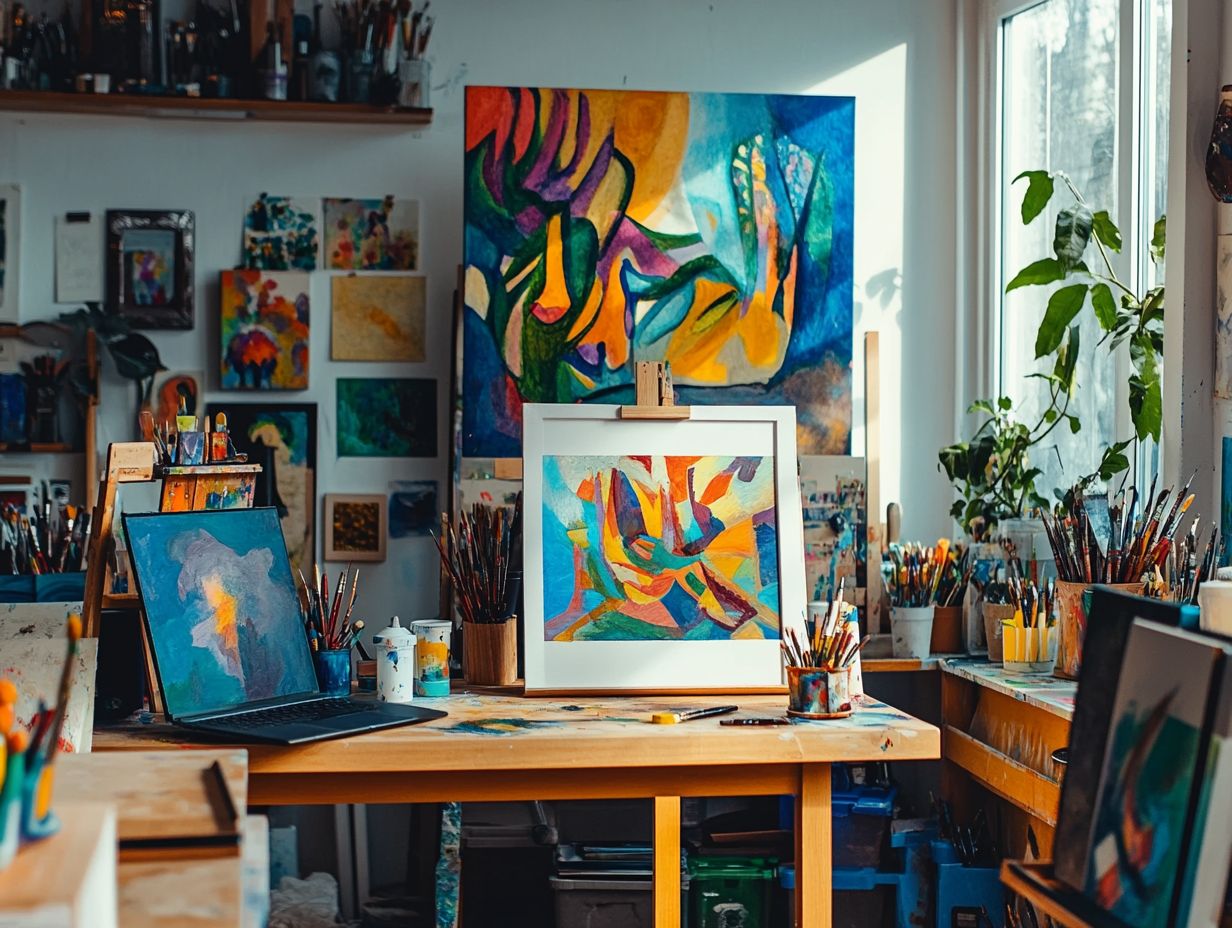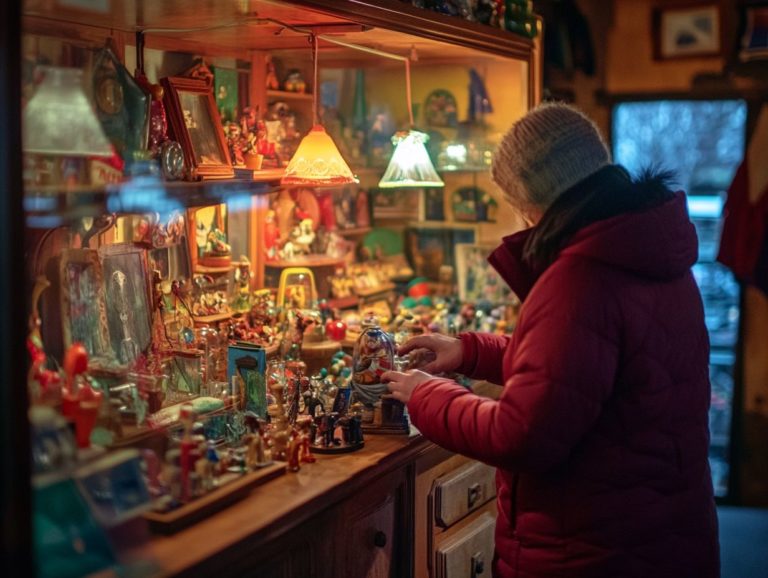5 Best Practices for Selling Your Art Collection
Selling your art collection can be an exciting yet daunting venture. Whether you want to downsize, profit from your investments, or share your passion, understanding the process is key to achieving great results.
This article explores five essential practices to guide you on your journey. You ll learn how to research the market, set realistic expectations, and market your collection effectively.
It also discusses how to find the right buyer, avoid common pitfalls, and manage the logistics involved.
Get ready to turn your artistic treasures into amazing opportunities!
Contents
- Key Takeaways:
- 1. Research the Market and Set Realistic Expectations
- 2. Determine the Value of Your Collection
- 3. Seek Professional Help
- 4. Market Your Collection Effectively
- 5. Be Prepared for Negotiations and Sales
- Want to find the right buyer for your art collection?
- What Are the Different Ways to Sell Your Art Collection?
- How Can You Protect Yourself from Fraudulent Buyers?
- What Are the Tax Implications of Selling an Art Collection?
- How Should You Handle the Logistics of Selling Your Collection?
- What Are Some Common Mistakes to Avoid When Selling an Art Collection?
- Frequently Asked Questions
- What are the 5 best practices for selling your art collection?
- Why is it important to research the market before selling your art collection?
- How can I properly maintain my art collection before selling?
- Is it necessary to get an appraisal for my art collection?
- What are some effective ways to generate interest in my art collection?
- Can I sell my art collection online or should I stick to traditional methods?
Key Takeaways:

Here are some crucial points to remember when selling your art collection!
- Do your research and set realistic expectations, as the market can be unpredictable.
- Seek professional help to determine the value of your collection and navigate the selling process.
- Market your collection effectively through various channels, such as galleries, auctions, and online platforms.
1. Research the Market and Set Realistic Expectations
In the world of selling artwork, doing thorough market research is crucial for understanding the details of the art market. This helps you find potential buyers and set expectations that match your art’s value and overall vision.
This process clarifies your target audience and informs your pricing and marketing plans, paving the way for successful online sales and effective engagement.
By using specific research methods like analyzing recent art exhibitions and connecting with the art community you can discover valuable insights that enhance your approach.
Attending gallery openings and art fairs gives you a front-row seat to trends and preferences, while conversations with patrons reveal key audience insights. Defining potential buyers using this information is essential for tailoring your outreach.
Setting realistic expectations about pricing and sales volume not only prevents disappointment but also builds your credibility. For example, creating a consistent brand through visual elements like a unique logo or color palette can boost recognition and resonate with your audience, ultimately leading to greater sales success.
2. Determine the Value of Your Collection
Figuring out the value of your collection is a vital step in the selling process. This involves carefully assessing the market worth of your artwork and considering factors like pricing transparency and its appeal to collectors and buyers.
Working with a professional art appraiser can provide you with an objective analysis of your pieces. They offer insights into their historical significance and current market trends. Understanding the value of limited editions can increase their desirability, making them more appealing to buyers.
Proper documentation, like certificates of authenticity and condition reports, builds trust and enhances the perceived value of your collection. By thoroughly valuing your collection, you can create a focused sales strategy that resonates with your target audience, improving buyer engagement and streamlining the transaction process.
3. Seek Professional Help
Getting professional assistance can greatly enhance your ability to sell artwork, whether through gallery representation, auction houses, or art commissions that create extra revenue streams and connect you with potential buyers.
These channels boost your visibility and establish your credibility in the competitive art market. Galleries play a vital role in curating exhibitions that showcase new talent, attracting art enthusiasts and collectors eager for fresh works. Auction houses offer a unique platform for high-value pieces, often drawing affluent buyers ready to invest in exclusive collections.
Prioritizing customer service builds lasting relationships with buyers. Personalized engagement fosters loyalty, encourages repeat purchases, and can lead to referrals that significantly expand your reach as an artist.
4. Market Your Collection Effectively

Effectively marketing your collection requires a meticulously crafted marketing plan that harnesses the power of social media platforms and visual storytelling. This approach not only engages potential buyers but also elevates your digital storefront’s visibility in the art market.
You should post stunning visuals of your pieces often! Share intriguing behind-the-scenes content that unveils your creative process. This fosters a genuine connection with your audience and deepens their appreciation for your art. Hosting art shows can create intimate encounters, allowing you to interact personally with potential buyers and nurture a stronger appreciation for your work.
To further amplify your visibility, a well-optimized website equipped with strong SEO strategies, which help your site appear in search results, is crucial for attracting organic traffic. Consider incorporating targeted keywords that resonate with your art genre and invest in local SEO to connect with nearby enthusiasts.
Use analytics to understand audience preferences. This helps you tailor your promotional efforts for maximum impact.
5. Be Prepared for Negotiations and Sales
Being ready for negotiations and sales is crucial! Developing good negotiation skills enhances buyer engagement and fosters emotional connections with potential customers, ensuring your pricing strategy aligns with market expectations.
Once you make that initial contact, understanding buyer motivations is key. This allows you to communicate in a way that truly resonates with prospective collectors. Active listening and posing insightful questions can uncover their preferences and budget constraints.
As you navigate the sales process, consider employing effective negotiation strategies, such as offering limited-time deals or providing exclusive insights into the artwork’s backstory. This creates a sense of urgency and desire. Equally important is maintaining the integrity of the art; present it in a way that reflects its true value while being transparent about its provenance and condition. Balancing assertiveness with empathy can elevate a simple transaction into a lasting relationship.
Want to find the right buyer for your art collection?
Finding the right buyer for your art collection requires targeted strategies that engage art collectors and deepen your understanding of their preferences. Additionally, exploring creative ways to display your art collection can enhance your chances of successful transactions by attracting more interest.
Start by researching potential buyers and analyzing their behavior at art exhibitions. These interactions can provide invaluable insights. Engaging in conversations during these events offers a unique opportunity to gauge interest and build meaningful connections.
Utilize online platforms and social media to showcase your work. Create an account on popular art sites to start showcasing your work and reach a wider audience that truly appreciates art. Building relationships with fellow artists, gallery owners, and collectors boosts your visibility and can lead to valuable referrals and collaborative opportunities.
Networking within these circles fosters trust and cultivates a supportive environment, encouraging potential buyers to invest in your collection.
What Are the Different Ways to Sell Your Art Collection?
There are numerous ways for you to sell your art collection, each presenting distinct advantages tailored to different preferences.
You might consider online sales through a digital storefront, traditional gallery representation, or even participating in auction houses and art shows that draw diverse audiences.
Online platforms can offer you an expansive reach, connecting you with potential buyers around the globe especially if you have a strong online presence. However, this method might lack the personal interaction and engagement that galleries often provide.
On the other hand, gallery representation fosters meaningful relationships with collectors, enhancing the perceived value of your work, though it may confine your visibility to a more localized audience.
When deciding on the best approach, reflect on the unique characteristics of your collection and the demographics of your target market. This way, you can choose a method that aligns with your goals and maximizes the exposure of your art.
How Can You Protect Yourself from Fraudulent Buyers?

Protecting yourself from fraudulent buyers is crucial in the art market. By implementing a clear pricing strategy and engaging with buyers through effective communication, you can establish trust and mitigate risks.
To enhance your credibility during transactions, collaborating with certified art appraisers for authentication is essential. They provide invaluable insights into the legitimacy and value of the art pieces, assuring both you and the buyer about the item’s provenance.
Transparency in pricing cannot be overstated. Offering detailed breakdowns of costs helps alleviate doubts and facilitates smoother negotiations. By maintaining high customer service standards prompt communication and courteous interactions you create a secure environment.
By prioritizing these strategies, you not only safeguard yourself but also cultivate lasting relationships with buyers. Start applying these strategies today to secure your art transactions!
What Are the Tax Implications of Selling an Art Collection?
Selling an art collection introduces many tax implications that you must navigate effectively. This includes grasping the nuances of capital gains tax, sales tax, and the crucial need for pricing transparency throughout your sales process.
To start, determining your capital gains tax requires you to calculate the difference between the selling price and the original purchase price of each art piece. If your pieces have appreciated significantly in value, these gains need to be reported on your tax returns.
Depending on your jurisdiction, sales tax might also come into play. This means you’ll need to keep proper documentation and possibly register as a seller. Talking to an art appraiser could prove invaluable; not only can they provide an assessment of your pieces’ current market value, but this valuation can also substantiate your selling price and offer essential backing during tax filings.
By ensuring accurate reporting and utilizing professional valuations, you can navigate the complexities of tax obligations with greater confidence and poise.
How Should You Handle the Logistics of Selling Your Collection?
Handling the logistics of selling your collection effectively is essential for ensuring a smooth sales process. This involves everything from shipping art pieces to managing customer service while maintaining prompt communication with your buyers.
To achieve this, consider reliable packaging options that safeguard the integrity of your art, ensuring it arrives at its destination in pristine condition. Exploring various shipping options, including expedited and international services, allows you to cater to a diverse clientele, enhancing their overall experience.
Efficient management of art commissions is also key. Communicate clearly about timelines and expectations to keep your buyers excited and informed! Providing progress updates helps your clients feel involved and valued throughout the process.
Streamlining these logistical elements not only boosts your operational efficiency but also significantly enhances buyer satisfaction, fostering long-term relationships and encouraging repeat business.
What Are Some Common Mistakes to Avoid When Selling an Art Collection?
Avoiding common mistakes when selling your art collection is paramount for achieving success. Issues like mispricing, poor buyer engagement, and inadequate communication can seriously undermine your sales outcomes. To navigate this effectively, consider the 5 things every art collector should know.
Underestimating the true value of your art pieces might lead you to set unreasonably low prices. Failing to connect with potential buyers can mean missing valuable conversations that could enhance your selling experience.
A solid pricing strategy is essential; neglecting this aspect can create confusion and deter serious collectors. To navigate these pitfalls effectively, thorough preparation and extensive research are essential.
Consider consulting with art appraisers to gain insight into current market trends and establish a fair pricing model. Actively engaging with buyers through targeted marketing and clear communication can foster a more appealing atmosphere, ultimately strengthening connections and driving sales.
Frequently Asked Questions

What are the 5 best practices for selling your art collection?
- Research the market and determine the value of your collection.
- Clean and take care of your artwork before selling.
- Utilize professional appraisal services for accurate pricing.
- Network with galleries, dealers, and buyers to generate interest.
- Sell through online platforms or auctions for wider reach and better prices.
Why is it important to research the market before selling your art collection?
Researching the market helps you understand the current demand and value for your collection. It also guides you on the best time and place to sell for maximum profit.
How can I properly maintain my art collection before selling?
Maintenance involves cleaning, repairing any damage, and storing the artwork properly. This keeps it in good condition and attracts potential buyers.
Is it necessary to get an appraisal for my art collection?
Yes, a professional appraisal gives an accurate and unbiased valuation of your collection. It also documents the value for potential buyers.
What are some effective ways to generate interest in my art collection?
Networking with galleries, dealers, and potential buyers is key. Use social media and online platforms to showcase your art and reach a larger audience.
Can I sell my art collection online or should I stick to traditional methods?
You can sell your art collection online through auctions or art marketplaces for greater visibility and potentially higher prices. Traditional methods, like working with galleries, can offer personalized connections with serious buyers.





